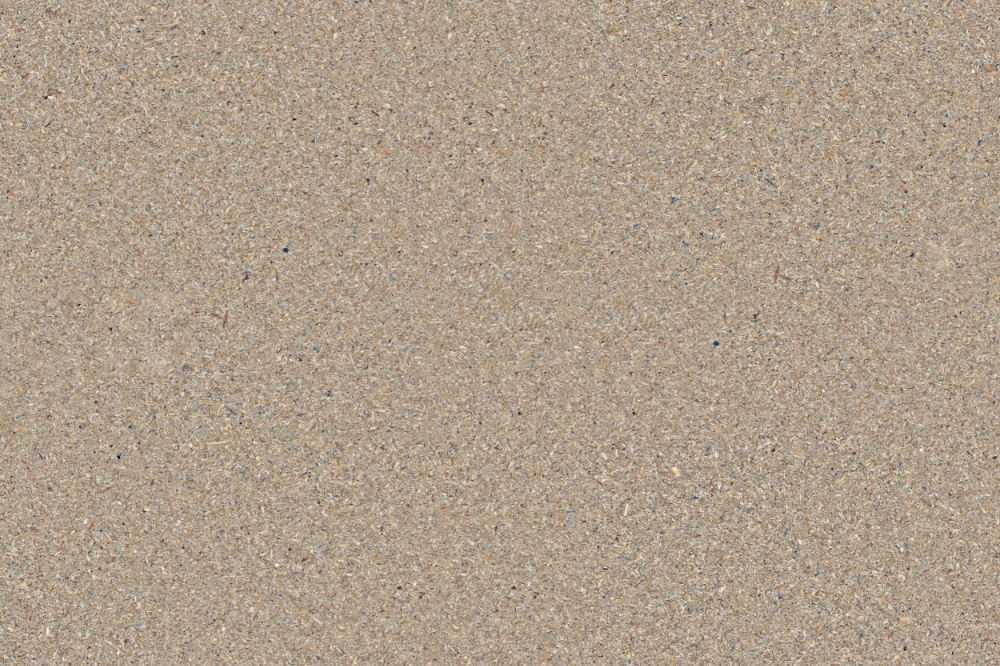MR Chipboard
Category
Wood
Download
Edit
Moisture resistant chipboard is a form of treated density fibreboard, predominantly used ‘naked’ as a flooring material, or as a backing layer for flooring surfaces such as laminates and synthetic carpets. Lower density, therefore weaker than medium or high density fibreboard (MDF and HDF, or hardboard, respectively), sheets are typically manufactured in 18 and 22mm depths and often cut with jointed edges, meaning they can be easily installed and joined together on site. As the lower density variant of MDF, particleboard is extremely cheap to manufacture in comparison to higher density composites or real timber panels, as it is comprised from offcuts and reconstituted shavings, sawdust and chippings – hence the name chipboard – leftover by-products of cutting raw timber boards. The re-use, or up-cycling, of timber offcuts make for a very cost effective panel that, alongside its primary use as flooring, can be used to construct elements of furniture and cabinet frames, or as a facing material for headboards, shelving, door surfaces, cupboards and work surfaces, as well as being used as the backing board for more decorative timber veneers, or for flooring and wall panelling in lofts and garden sheds where a cheap, practical, perfunctory surface is required. By compressing the fibres and binding using natural or synthetic resins, chipboard can be as, if not more, structurally dense, strong and malleable as some real, raw sheets of timber at a much lower cost. Additionally, the more fibrous and dense the board, the better it will cut when sawing and working, while holding fixings without flaking or cracking. Reasonably dense and durable, chipboard has risen to popularity with flat pack furniture manufacturers and DIY enthusiasts since its invention in the 1950s due to its versatility, cost efficiency and ease of use and forgiving workability. Manufactured timber sheets can also be produced in dimensions which exceed those of real timber sheets, which are limited by the width, quality and knot frequency of the origin tree.
Particleboard is much more economical, resourceful and, to an extent, more environmentally sound than mass production of real timber sheets as they are composed from the bye products and offcuts of real timber sheeting. Its density and fibrous nature also help provide more purchase for fixings, such as screws and nails, without cracking or fracturing under stress, which is particularly common in interlocking grained species of timber. Being fibre based, users will find a greater degree of control and certainty when cutting or screwing, as the consistent density throughout and lack of knots or other obstacles prevents ‘biting’ when working, or the slippage of fixings. Additionally, with suitable protective coatings and finish treatments such as the moisture resistant resin-based finish on this texture, chipboard is durable, providing excellent resistance against moisture ingress and susceptibility to insect infestation while remaining fairly easy to work with.
This particular chipboard texture has a dull, sandy-grey golden-brown appearance, with the wood fibers and shavings evident on the surface, adding a mottled, granular element of detail with lighter and darker strips of varying length and timber species added into the mix. MR chipboard is most commonly used on flooring, but can be used as backing board and on some structural elements of furniture, as a low-cost decorative element on doors, cupboards, shelving and wall panelling, or as a backing for more refined timber veneers. Although usually hidden away, the exposed surface has become popular in low-cost, rugged and raw or unfinished interior aesthetics to express a hand-crafted approach, or painted a variety of bright, cheery, expressive colours. The moisture resisting treatment allows it to be used in kitchen and bathroom applications, while it is also a suitable, durable, indoor flooring material.
A seamless wood texture with a mr chipboard surface. Seamless textures can be tiled repeatedly across a surface without visible seams making them useful for architectural drawings and 3D models. This image can be used as a SketchUp texture, Revit material or imported into Photoshop for use in 2D illustrations. A high resolution version of this texture is available, as well as CAD hatches and PBR maps with Architextures Pro.

